Project Report: Virtual Reality in Surgical Planning and Training
VerifiedAdded on 2019/09/21
|12
|2821
|403
Project
AI Summary
This project report examines the transformative role of virtual reality (VR) in surgical planning and training. It begins with an introduction highlighting VR's potential to revolutionize medical education and practice, followed by a historical overview of VR's evolution. The report then delves into the characteristics of VR in surgery, discussing its impact on training and planning. Key components of VR technology, including hardware and software, are explained, along with the system's architecture. The report further analyzes the opportunities, advantages, and limitations of VR in surgical applications, emphasizing its potential for skill enhancement and cost-effectiveness while acknowledging current limitations. Finally, the report concludes with findings and recommendations for future research and development in this rapidly evolving field, making it a valuable resource for understanding VR's impact on healthcare.
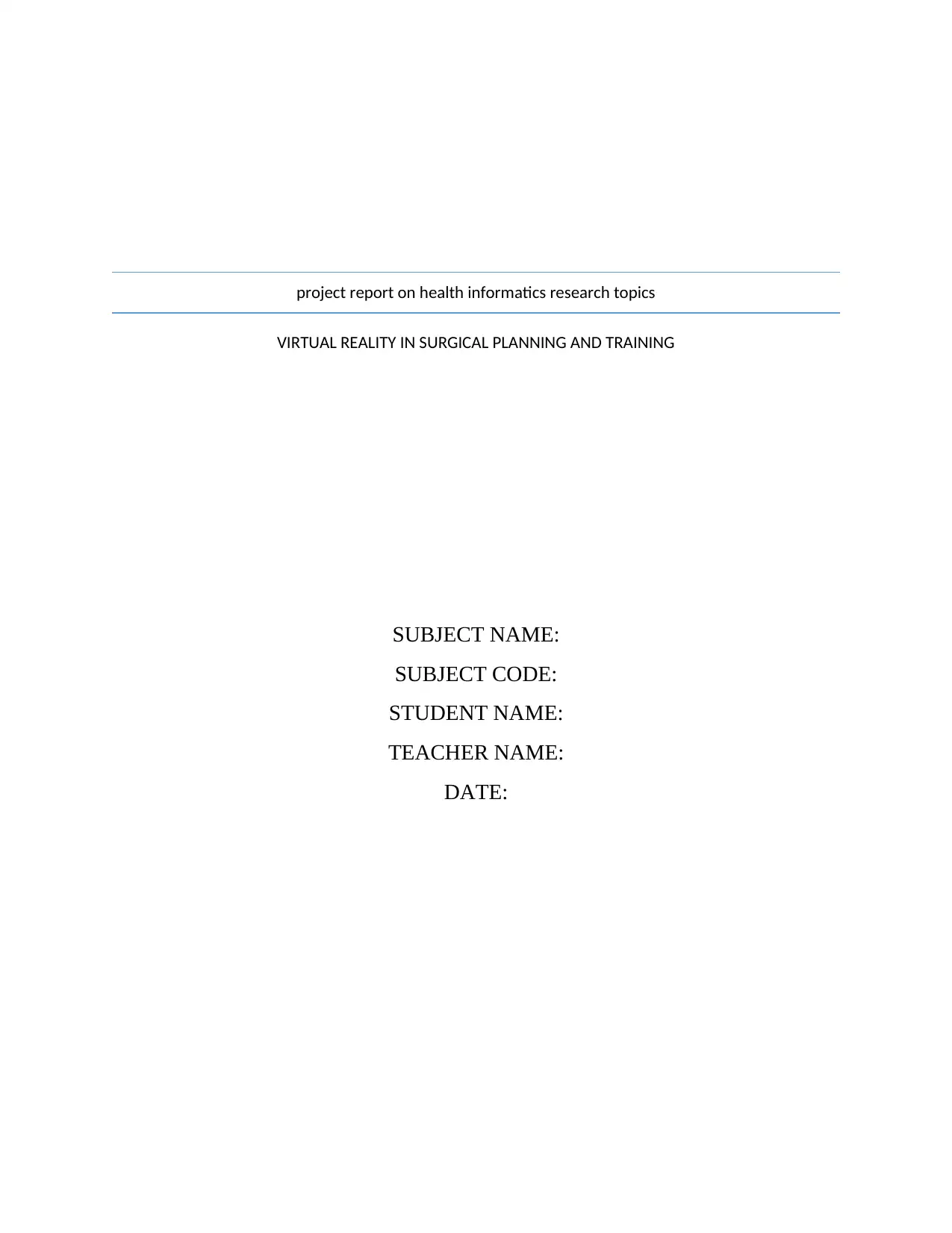
project report on health informatics research topics
VIRTUAL REALITY IN SURGICAL PLANNING AND TRAINING
SUBJECT NAME:
SUBJECT CODE:
STUDENT NAME:
TEACHER NAME:
DATE:
VIRTUAL REALITY IN SURGICAL PLANNING AND TRAINING
SUBJECT NAME:
SUBJECT CODE:
STUDENT NAME:
TEACHER NAME:
DATE:
Paraphrase This Document
Need a fresh take? Get an instant paraphrase of this document with our AI Paraphraser
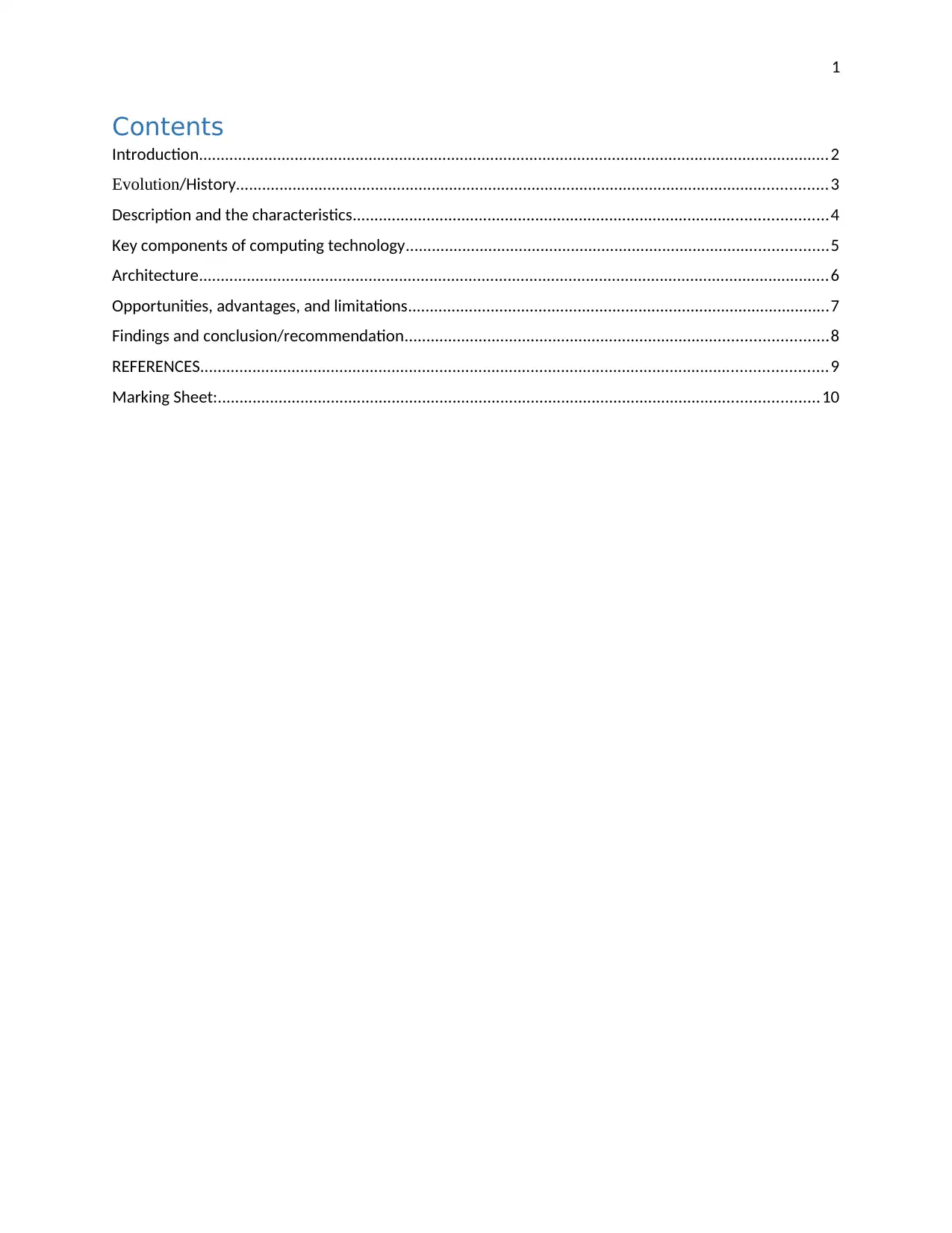
1
Contents
Introduction.................................................................................................................................................2
Evolution/History........................................................................................................................................3
Description and the characteristics.............................................................................................................4
Key components of computing technology.................................................................................................5
Architecture.................................................................................................................................................6
Opportunities, advantages, and limitations.................................................................................................7
Findings and conclusion/recommendation.................................................................................................8
REFERENCES................................................................................................................................................9
Marking Sheet:..........................................................................................................................................10
Contents
Introduction.................................................................................................................................................2
Evolution/History........................................................................................................................................3
Description and the characteristics.............................................................................................................4
Key components of computing technology.................................................................................................5
Architecture.................................................................................................................................................6
Opportunities, advantages, and limitations.................................................................................................7
Findings and conclusion/recommendation.................................................................................................8
REFERENCES................................................................................................................................................9
Marking Sheet:..........................................................................................................................................10
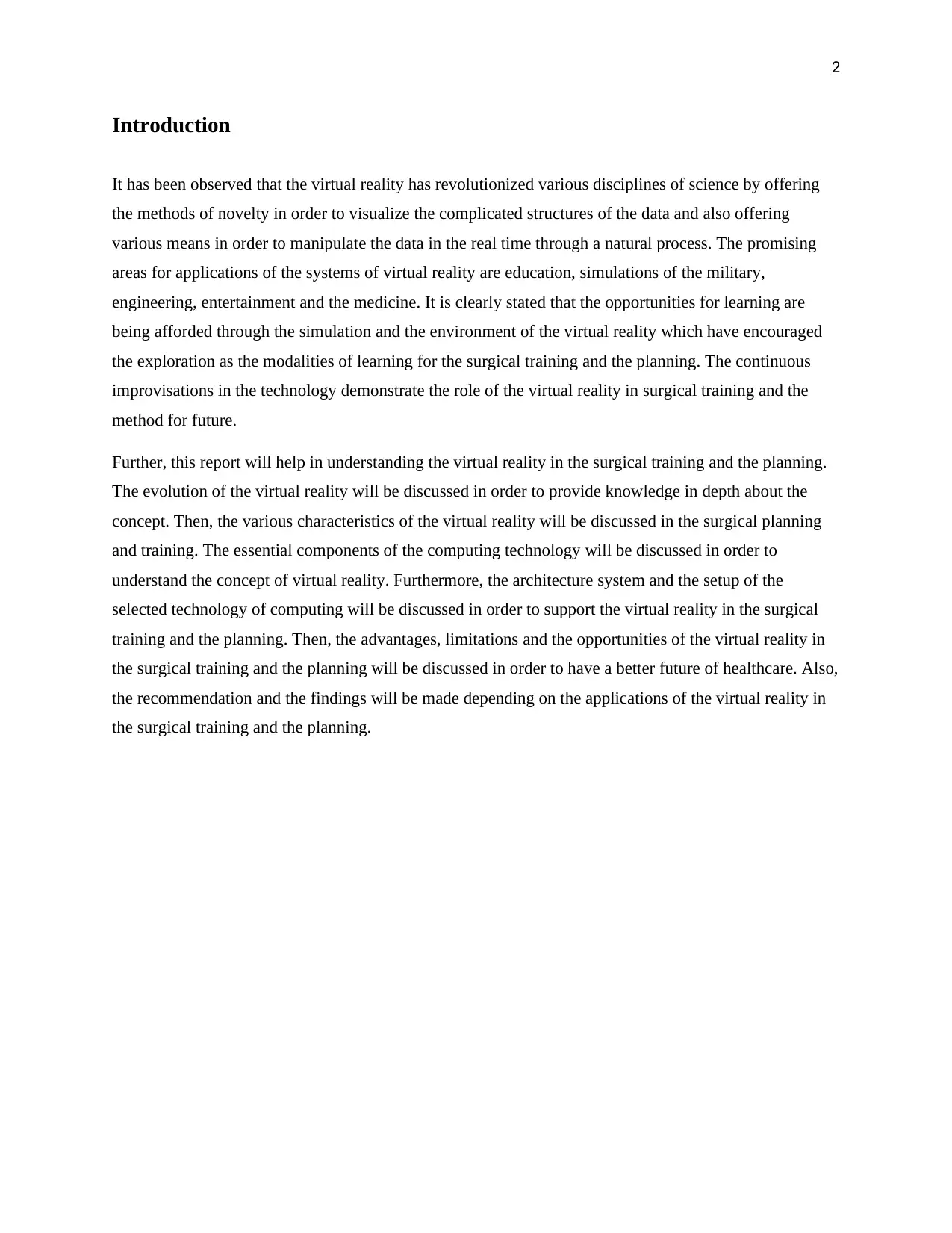
2
Introduction
It has been observed that the virtual reality has revolutionized various disciplines of science by offering
the methods of novelty in order to visualize the complicated structures of the data and also offering
various means in order to manipulate the data in the real time through a natural process. The promising
areas for applications of the systems of virtual reality are education, simulations of the military,
engineering, entertainment and the medicine. It is clearly stated that the opportunities for learning are
being afforded through the simulation and the environment of the virtual reality which have encouraged
the exploration as the modalities of learning for the surgical training and the planning. The continuous
improvisations in the technology demonstrate the role of the virtual reality in surgical training and the
method for future.
Further, this report will help in understanding the virtual reality in the surgical training and the planning.
The evolution of the virtual reality will be discussed in order to provide knowledge in depth about the
concept. Then, the various characteristics of the virtual reality will be discussed in the surgical planning
and training. The essential components of the computing technology will be discussed in order to
understand the concept of virtual reality. Furthermore, the architecture system and the setup of the
selected technology of computing will be discussed in order to support the virtual reality in the surgical
training and the planning. Then, the advantages, limitations and the opportunities of the virtual reality in
the surgical training and the planning will be discussed in order to have a better future of healthcare. Also,
the recommendation and the findings will be made depending on the applications of the virtual reality in
the surgical training and the planning.
Introduction
It has been observed that the virtual reality has revolutionized various disciplines of science by offering
the methods of novelty in order to visualize the complicated structures of the data and also offering
various means in order to manipulate the data in the real time through a natural process. The promising
areas for applications of the systems of virtual reality are education, simulations of the military,
engineering, entertainment and the medicine. It is clearly stated that the opportunities for learning are
being afforded through the simulation and the environment of the virtual reality which have encouraged
the exploration as the modalities of learning for the surgical training and the planning. The continuous
improvisations in the technology demonstrate the role of the virtual reality in surgical training and the
method for future.
Further, this report will help in understanding the virtual reality in the surgical training and the planning.
The evolution of the virtual reality will be discussed in order to provide knowledge in depth about the
concept. Then, the various characteristics of the virtual reality will be discussed in the surgical planning
and training. The essential components of the computing technology will be discussed in order to
understand the concept of virtual reality. Furthermore, the architecture system and the setup of the
selected technology of computing will be discussed in order to support the virtual reality in the surgical
training and the planning. Then, the advantages, limitations and the opportunities of the virtual reality in
the surgical training and the planning will be discussed in order to have a better future of healthcare. Also,
the recommendation and the findings will be made depending on the applications of the virtual reality in
the surgical training and the planning.
⊘ This is a preview!⊘
Do you want full access?
Subscribe today to unlock all pages.

Trusted by 1+ million students worldwide
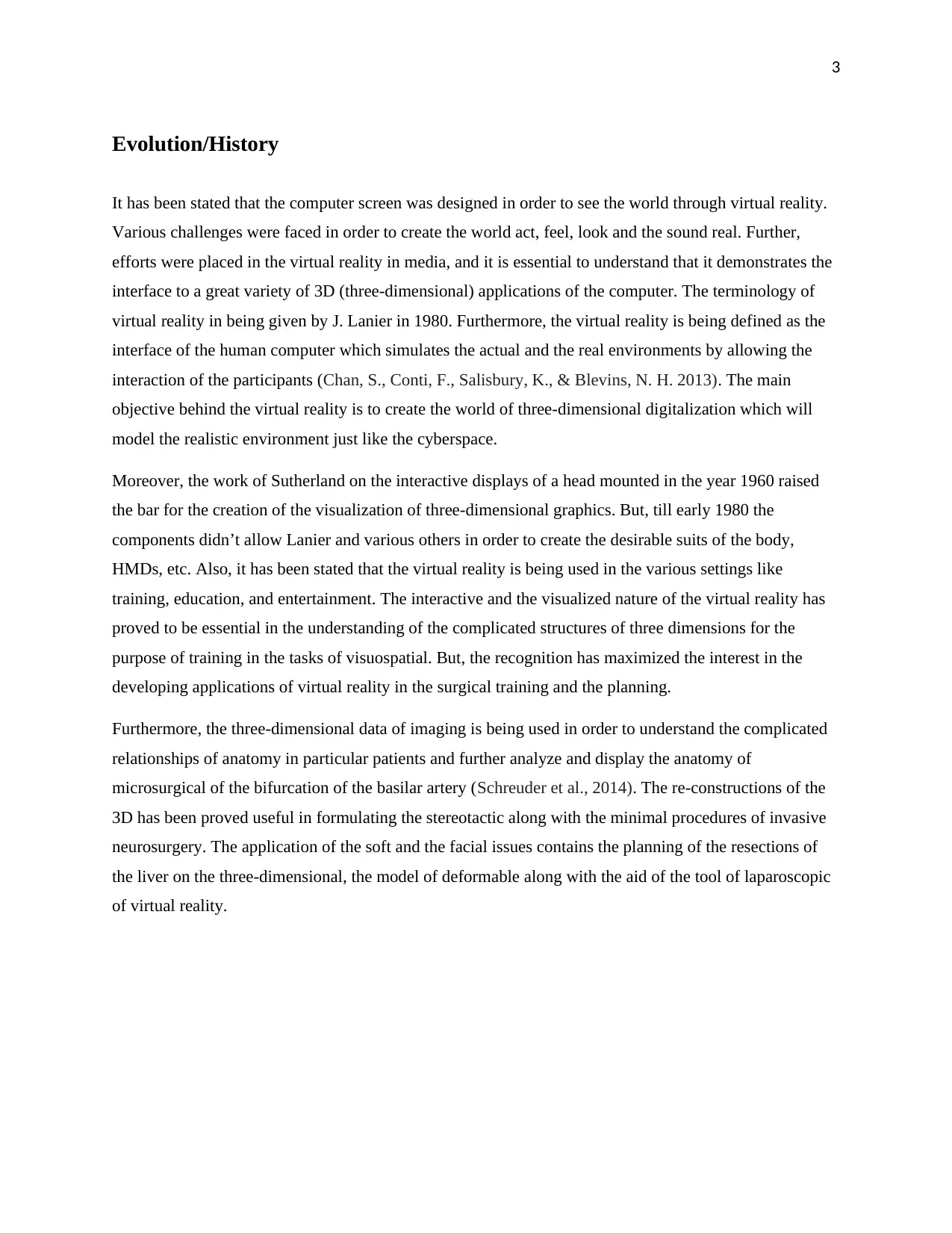
3
Evolution/History
It has been stated that the computer screen was designed in order to see the world through virtual reality.
Various challenges were faced in order to create the world act, feel, look and the sound real. Further,
efforts were placed in the virtual reality in media, and it is essential to understand that it demonstrates the
interface to a great variety of 3D (three-dimensional) applications of the computer. The terminology of
virtual reality in being given by J. Lanier in 1980. Furthermore, the virtual reality is being defined as the
interface of the human computer which simulates the actual and the real environments by allowing the
interaction of the participants (Chan, S., Conti, F., Salisbury, K., & Blevins, N. H. 2013). The main
objective behind the virtual reality is to create the world of three-dimensional digitalization which will
model the realistic environment just like the cyberspace.
Moreover, the work of Sutherland on the interactive displays of a head mounted in the year 1960 raised
the bar for the creation of the visualization of three-dimensional graphics. But, till early 1980 the
components didn’t allow Lanier and various others in order to create the desirable suits of the body,
HMDs, etc. Also, it has been stated that the virtual reality is being used in the various settings like
training, education, and entertainment. The interactive and the visualized nature of the virtual reality has
proved to be essential in the understanding of the complicated structures of three dimensions for the
purpose of training in the tasks of visuospatial. But, the recognition has maximized the interest in the
developing applications of virtual reality in the surgical training and the planning.
Furthermore, the three-dimensional data of imaging is being used in order to understand the complicated
relationships of anatomy in particular patients and further analyze and display the anatomy of
microsurgical of the bifurcation of the basilar artery (Schreuder et al., 2014). The re-constructions of the
3D has been proved useful in formulating the stereotactic along with the minimal procedures of invasive
neurosurgery. The application of the soft and the facial issues contains the planning of the resections of
the liver on the three-dimensional, the model of deformable along with the aid of the tool of laparoscopic
of virtual reality.
Evolution/History
It has been stated that the computer screen was designed in order to see the world through virtual reality.
Various challenges were faced in order to create the world act, feel, look and the sound real. Further,
efforts were placed in the virtual reality in media, and it is essential to understand that it demonstrates the
interface to a great variety of 3D (three-dimensional) applications of the computer. The terminology of
virtual reality in being given by J. Lanier in 1980. Furthermore, the virtual reality is being defined as the
interface of the human computer which simulates the actual and the real environments by allowing the
interaction of the participants (Chan, S., Conti, F., Salisbury, K., & Blevins, N. H. 2013). The main
objective behind the virtual reality is to create the world of three-dimensional digitalization which will
model the realistic environment just like the cyberspace.
Moreover, the work of Sutherland on the interactive displays of a head mounted in the year 1960 raised
the bar for the creation of the visualization of three-dimensional graphics. But, till early 1980 the
components didn’t allow Lanier and various others in order to create the desirable suits of the body,
HMDs, etc. Also, it has been stated that the virtual reality is being used in the various settings like
training, education, and entertainment. The interactive and the visualized nature of the virtual reality has
proved to be essential in the understanding of the complicated structures of three dimensions for the
purpose of training in the tasks of visuospatial. But, the recognition has maximized the interest in the
developing applications of virtual reality in the surgical training and the planning.
Furthermore, the three-dimensional data of imaging is being used in order to understand the complicated
relationships of anatomy in particular patients and further analyze and display the anatomy of
microsurgical of the bifurcation of the basilar artery (Schreuder et al., 2014). The re-constructions of the
3D has been proved useful in formulating the stereotactic along with the minimal procedures of invasive
neurosurgery. The application of the soft and the facial issues contains the planning of the resections of
the liver on the three-dimensional, the model of deformable along with the aid of the tool of laparoscopic
of virtual reality.
Paraphrase This Document
Need a fresh take? Get an instant paraphrase of this document with our AI Paraphraser
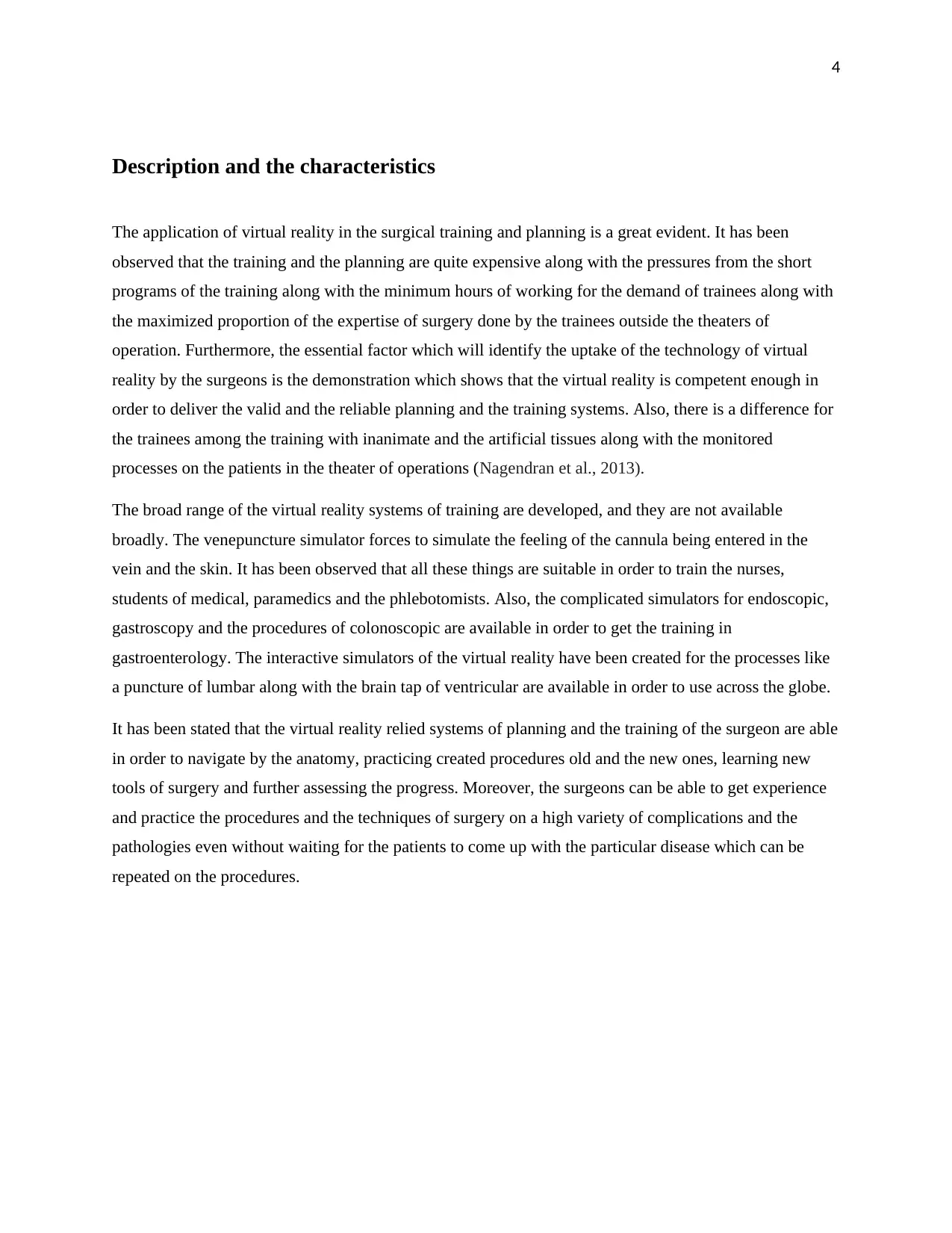
4
Description and the characteristics
The application of virtual reality in the surgical training and planning is a great evident. It has been
observed that the training and the planning are quite expensive along with the pressures from the short
programs of the training along with the minimum hours of working for the demand of trainees along with
the maximized proportion of the expertise of surgery done by the trainees outside the theaters of
operation. Furthermore, the essential factor which will identify the uptake of the technology of virtual
reality by the surgeons is the demonstration which shows that the virtual reality is competent enough in
order to deliver the valid and the reliable planning and the training systems. Also, there is a difference for
the trainees among the training with inanimate and the artificial tissues along with the monitored
processes on the patients in the theater of operations (Nagendran et al., 2013).
The broad range of the virtual reality systems of training are developed, and they are not available
broadly. The venepuncture simulator forces to simulate the feeling of the cannula being entered in the
vein and the skin. It has been observed that all these things are suitable in order to train the nurses,
students of medical, paramedics and the phlebotomists. Also, the complicated simulators for endoscopic,
gastroscopy and the procedures of colonoscopic are available in order to get the training in
gastroenterology. The interactive simulators of the virtual reality have been created for the processes like
a puncture of lumbar along with the brain tap of ventricular are available in order to use across the globe.
It has been stated that the virtual reality relied systems of planning and the training of the surgeon are able
in order to navigate by the anatomy, practicing created procedures old and the new ones, learning new
tools of surgery and further assessing the progress. Moreover, the surgeons can be able to get experience
and practice the procedures and the techniques of surgery on a high variety of complications and the
pathologies even without waiting for the patients to come up with the particular disease which can be
repeated on the procedures.
Description and the characteristics
The application of virtual reality in the surgical training and planning is a great evident. It has been
observed that the training and the planning are quite expensive along with the pressures from the short
programs of the training along with the minimum hours of working for the demand of trainees along with
the maximized proportion of the expertise of surgery done by the trainees outside the theaters of
operation. Furthermore, the essential factor which will identify the uptake of the technology of virtual
reality by the surgeons is the demonstration which shows that the virtual reality is competent enough in
order to deliver the valid and the reliable planning and the training systems. Also, there is a difference for
the trainees among the training with inanimate and the artificial tissues along with the monitored
processes on the patients in the theater of operations (Nagendran et al., 2013).
The broad range of the virtual reality systems of training are developed, and they are not available
broadly. The venepuncture simulator forces to simulate the feeling of the cannula being entered in the
vein and the skin. It has been observed that all these things are suitable in order to train the nurses,
students of medical, paramedics and the phlebotomists. Also, the complicated simulators for endoscopic,
gastroscopy and the procedures of colonoscopic are available in order to get the training in
gastroenterology. The interactive simulators of the virtual reality have been created for the processes like
a puncture of lumbar along with the brain tap of ventricular are available in order to use across the globe.
It has been stated that the virtual reality relied systems of planning and the training of the surgeon are able
in order to navigate by the anatomy, practicing created procedures old and the new ones, learning new
tools of surgery and further assessing the progress. Moreover, the surgeons can be able to get experience
and practice the procedures and the techniques of surgery on a high variety of complications and the
pathologies even without waiting for the patients to come up with the particular disease which can be
repeated on the procedures.
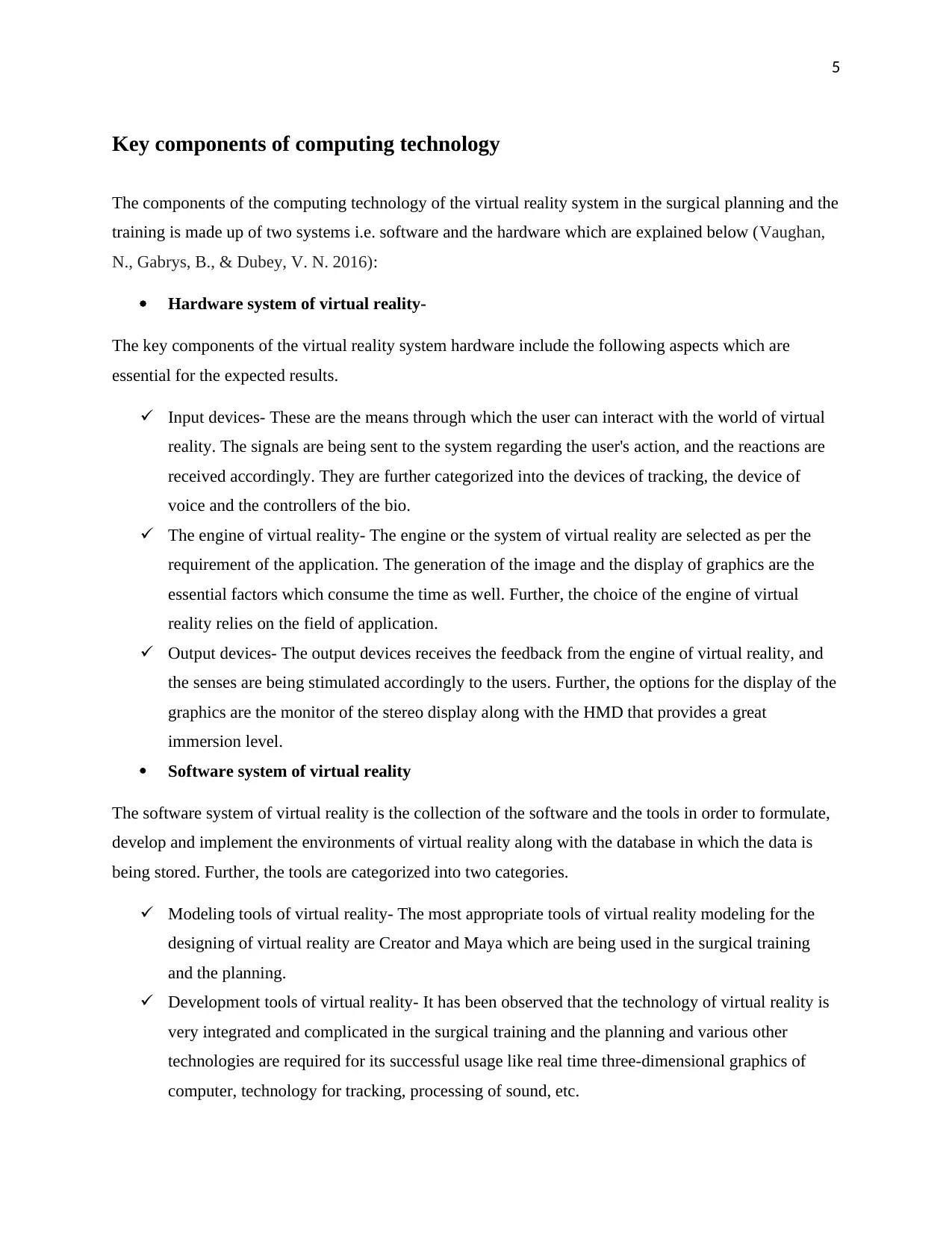
5
Key components of computing technology
The components of the computing technology of the virtual reality system in the surgical planning and the
training is made up of two systems i.e. software and the hardware which are explained below (Vaughan,
N., Gabrys, B., & Dubey, V. N. 2016):
Hardware system of virtual reality-
The key components of the virtual reality system hardware include the following aspects which are
essential for the expected results.
Input devices- These are the means through which the user can interact with the world of virtual
reality. The signals are being sent to the system regarding the user's action, and the reactions are
received accordingly. They are further categorized into the devices of tracking, the device of
voice and the controllers of the bio.
The engine of virtual reality- The engine or the system of virtual reality are selected as per the
requirement of the application. The generation of the image and the display of graphics are the
essential factors which consume the time as well. Further, the choice of the engine of virtual
reality relies on the field of application.
Output devices- The output devices receives the feedback from the engine of virtual reality, and
the senses are being stimulated accordingly to the users. Further, the options for the display of the
graphics are the monitor of the stereo display along with the HMD that provides a great
immersion level.
Software system of virtual reality
The software system of virtual reality is the collection of the software and the tools in order to formulate,
develop and implement the environments of virtual reality along with the database in which the data is
being stored. Further, the tools are categorized into two categories.
Modeling tools of virtual reality- The most appropriate tools of virtual reality modeling for the
designing of virtual reality are Creator and Maya which are being used in the surgical training
and the planning.
Development tools of virtual reality- It has been observed that the technology of virtual reality is
very integrated and complicated in the surgical training and the planning and various other
technologies are required for its successful usage like real time three-dimensional graphics of
computer, technology for tracking, processing of sound, etc.
Key components of computing technology
The components of the computing technology of the virtual reality system in the surgical planning and the
training is made up of two systems i.e. software and the hardware which are explained below (Vaughan,
N., Gabrys, B., & Dubey, V. N. 2016):
Hardware system of virtual reality-
The key components of the virtual reality system hardware include the following aspects which are
essential for the expected results.
Input devices- These are the means through which the user can interact with the world of virtual
reality. The signals are being sent to the system regarding the user's action, and the reactions are
received accordingly. They are further categorized into the devices of tracking, the device of
voice and the controllers of the bio.
The engine of virtual reality- The engine or the system of virtual reality are selected as per the
requirement of the application. The generation of the image and the display of graphics are the
essential factors which consume the time as well. Further, the choice of the engine of virtual
reality relies on the field of application.
Output devices- The output devices receives the feedback from the engine of virtual reality, and
the senses are being stimulated accordingly to the users. Further, the options for the display of the
graphics are the monitor of the stereo display along with the HMD that provides a great
immersion level.
Software system of virtual reality
The software system of virtual reality is the collection of the software and the tools in order to formulate,
develop and implement the environments of virtual reality along with the database in which the data is
being stored. Further, the tools are categorized into two categories.
Modeling tools of virtual reality- The most appropriate tools of virtual reality modeling for the
designing of virtual reality are Creator and Maya which are being used in the surgical training
and the planning.
Development tools of virtual reality- It has been observed that the technology of virtual reality is
very integrated and complicated in the surgical training and the planning and various other
technologies are required for its successful usage like real time three-dimensional graphics of
computer, technology for tracking, processing of sound, etc.
⊘ This is a preview!⊘
Do you want full access?
Subscribe today to unlock all pages.

Trusted by 1+ million students worldwide
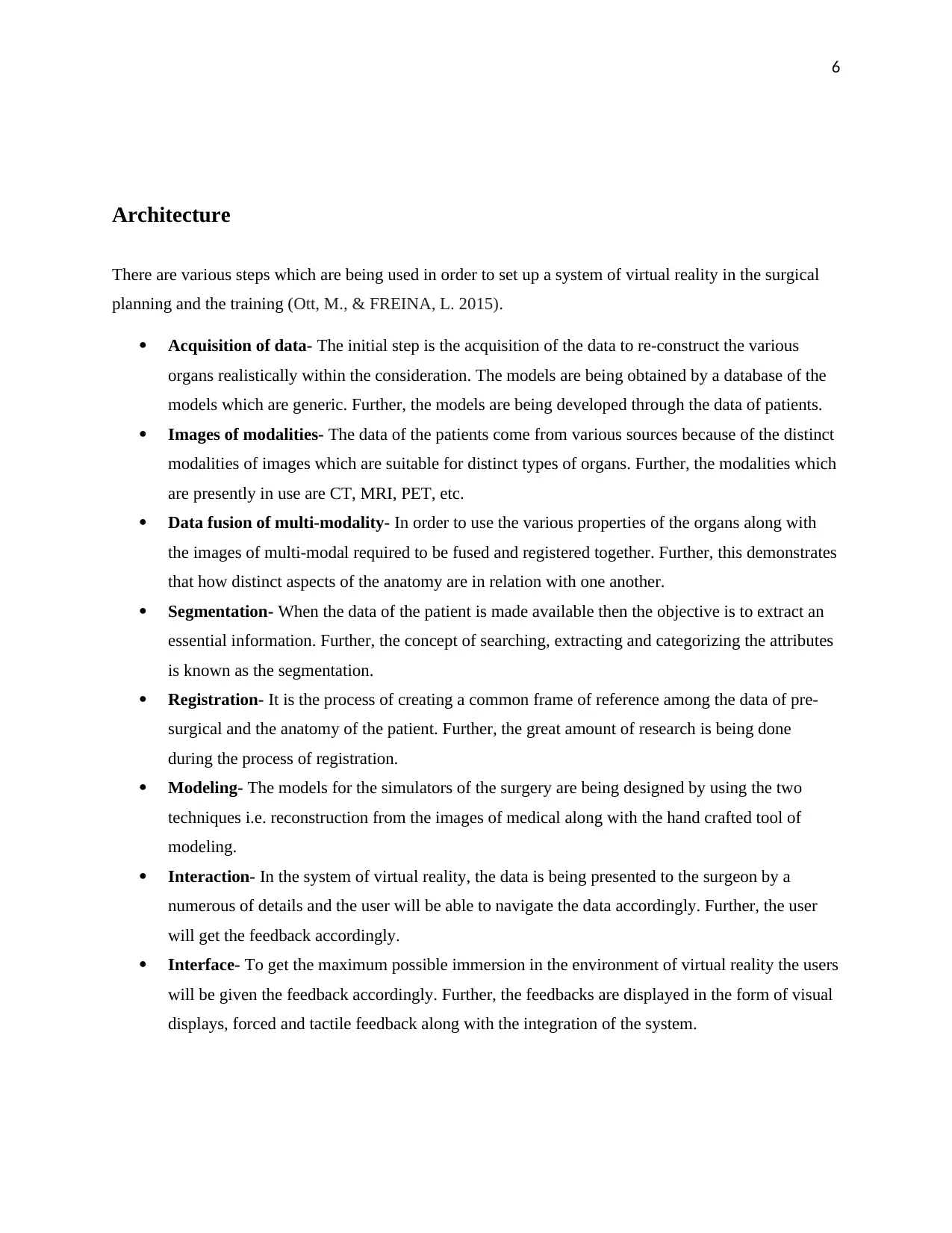
6
Architecture
There are various steps which are being used in order to set up a system of virtual reality in the surgical
planning and the training (Ott, M., & FREINA, L. 2015).
Acquisition of data- The initial step is the acquisition of the data to re-construct the various
organs realistically within the consideration. The models are being obtained by a database of the
models which are generic. Further, the models are being developed through the data of patients.
Images of modalities- The data of the patients come from various sources because of the distinct
modalities of images which are suitable for distinct types of organs. Further, the modalities which
are presently in use are CT, MRI, PET, etc.
Data fusion of multi-modality- In order to use the various properties of the organs along with
the images of multi-modal required to be fused and registered together. Further, this demonstrates
that how distinct aspects of the anatomy are in relation with one another.
Segmentation- When the data of the patient is made available then the objective is to extract an
essential information. Further, the concept of searching, extracting and categorizing the attributes
is known as the segmentation.
Registration- It is the process of creating a common frame of reference among the data of pre-
surgical and the anatomy of the patient. Further, the great amount of research is being done
during the process of registration.
Modeling- The models for the simulators of the surgery are being designed by using the two
techniques i.e. reconstruction from the images of medical along with the hand crafted tool of
modeling.
Interaction- In the system of virtual reality, the data is being presented to the surgeon by a
numerous of details and the user will be able to navigate the data accordingly. Further, the user
will get the feedback accordingly.
Interface- To get the maximum possible immersion in the environment of virtual reality the users
will be given the feedback accordingly. Further, the feedbacks are displayed in the form of visual
displays, forced and tactile feedback along with the integration of the system.
Architecture
There are various steps which are being used in order to set up a system of virtual reality in the surgical
planning and the training (Ott, M., & FREINA, L. 2015).
Acquisition of data- The initial step is the acquisition of the data to re-construct the various
organs realistically within the consideration. The models are being obtained by a database of the
models which are generic. Further, the models are being developed through the data of patients.
Images of modalities- The data of the patients come from various sources because of the distinct
modalities of images which are suitable for distinct types of organs. Further, the modalities which
are presently in use are CT, MRI, PET, etc.
Data fusion of multi-modality- In order to use the various properties of the organs along with
the images of multi-modal required to be fused and registered together. Further, this demonstrates
that how distinct aspects of the anatomy are in relation with one another.
Segmentation- When the data of the patient is made available then the objective is to extract an
essential information. Further, the concept of searching, extracting and categorizing the attributes
is known as the segmentation.
Registration- It is the process of creating a common frame of reference among the data of pre-
surgical and the anatomy of the patient. Further, the great amount of research is being done
during the process of registration.
Modeling- The models for the simulators of the surgery are being designed by using the two
techniques i.e. reconstruction from the images of medical along with the hand crafted tool of
modeling.
Interaction- In the system of virtual reality, the data is being presented to the surgeon by a
numerous of details and the user will be able to navigate the data accordingly. Further, the user
will get the feedback accordingly.
Interface- To get the maximum possible immersion in the environment of virtual reality the users
will be given the feedback accordingly. Further, the feedbacks are displayed in the form of visual
displays, forced and tactile feedback along with the integration of the system.
Paraphrase This Document
Need a fresh take? Get an instant paraphrase of this document with our AI Paraphraser

7

8
Opportunities, advantages, and limitations
The opportunities for the technology of virtual reality in surgical planning and the training are many
because the virtual reality in the field of surgical training and the planning is still at an initial stage in
terms of the paradigms of treatment and the widespread adoption of the clinical use. Further, the
innovators will be scrutinized increasingly in relation to the evidence for the efficacy of healthcare by
designing and controlling the trials adequately. Further, in future, the things will become more interesting
with the intersection and the integration of the technology such as virtual reality in the analytics of big
data.
The advantages of the technology of virtual reality in surgical planning and the training are many like the
model of virtual reality enables the providers in order to experience and practice the wound care, CPR,
etc. Further, the technology of virtual reality provides the great opportunity in order to hone the
capabilities and the skills in the scenario of the real world, and it further enables the application of hands-
on. This technology is mainly helpful for the students who have not performed the tasks earlier. Also, the
virtual reality provides the benefits of learning in the wide field i.e. healthcare, and the mistakes are being
treated as the tools of learning which do not handle the consequences which threaten the life (Waran, et
al., 2014).
The limitations of the technology of virtual reality in surgical planning and the training are many as
people who are more experienced and above the age group of 35 find it difficult to practice the
technology of virtual reality, and they are facing various challenges due to the new entrants in the
particular field of healthcare. Further, the broad acceptance of the virtual reality technology in the surgical
training and planning has overcome from various prejudices, but still, they are being viewed as the
gimmicks by the surgeons.
Opportunities, advantages, and limitations
The opportunities for the technology of virtual reality in surgical planning and the training are many
because the virtual reality in the field of surgical training and the planning is still at an initial stage in
terms of the paradigms of treatment and the widespread adoption of the clinical use. Further, the
innovators will be scrutinized increasingly in relation to the evidence for the efficacy of healthcare by
designing and controlling the trials adequately. Further, in future, the things will become more interesting
with the intersection and the integration of the technology such as virtual reality in the analytics of big
data.
The advantages of the technology of virtual reality in surgical planning and the training are many like the
model of virtual reality enables the providers in order to experience and practice the wound care, CPR,
etc. Further, the technology of virtual reality provides the great opportunity in order to hone the
capabilities and the skills in the scenario of the real world, and it further enables the application of hands-
on. This technology is mainly helpful for the students who have not performed the tasks earlier. Also, the
virtual reality provides the benefits of learning in the wide field i.e. healthcare, and the mistakes are being
treated as the tools of learning which do not handle the consequences which threaten the life (Waran, et
al., 2014).
The limitations of the technology of virtual reality in surgical planning and the training are many as
people who are more experienced and above the age group of 35 find it difficult to practice the
technology of virtual reality, and they are facing various challenges due to the new entrants in the
particular field of healthcare. Further, the broad acceptance of the virtual reality technology in the surgical
training and planning has overcome from various prejudices, but still, they are being viewed as the
gimmicks by the surgeons.
⊘ This is a preview!⊘
Do you want full access?
Subscribe today to unlock all pages.

Trusted by 1+ million students worldwide
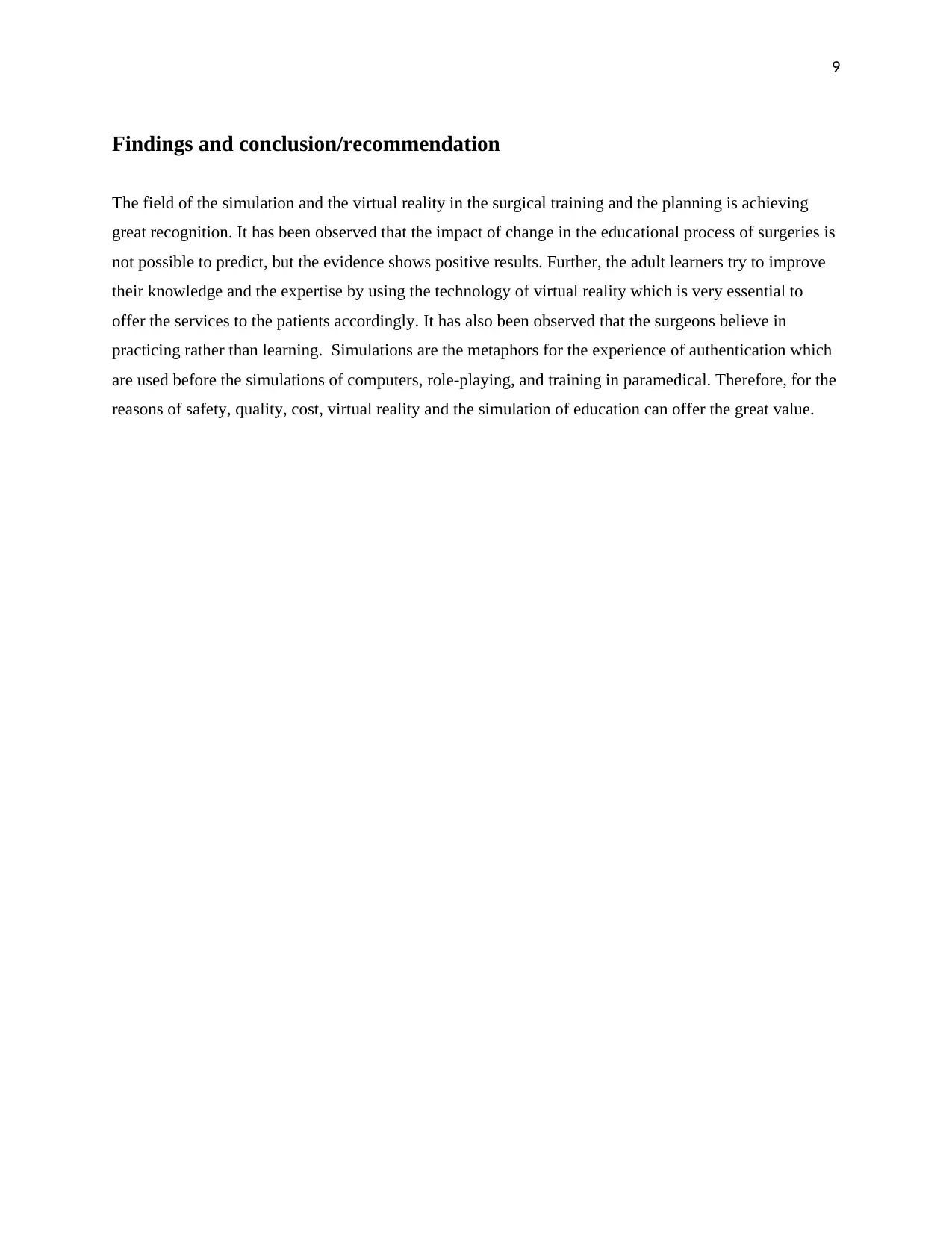
9
Findings and conclusion/recommendation
The field of the simulation and the virtual reality in the surgical training and the planning is achieving
great recognition. It has been observed that the impact of change in the educational process of surgeries is
not possible to predict, but the evidence shows positive results. Further, the adult learners try to improve
their knowledge and the expertise by using the technology of virtual reality which is very essential to
offer the services to the patients accordingly. It has also been observed that the surgeons believe in
practicing rather than learning. Simulations are the metaphors for the experience of authentication which
are used before the simulations of computers, role-playing, and training in paramedical. Therefore, for the
reasons of safety, quality, cost, virtual reality and the simulation of education can offer the great value.
Findings and conclusion/recommendation
The field of the simulation and the virtual reality in the surgical training and the planning is achieving
great recognition. It has been observed that the impact of change in the educational process of surgeries is
not possible to predict, but the evidence shows positive results. Further, the adult learners try to improve
their knowledge and the expertise by using the technology of virtual reality which is very essential to
offer the services to the patients accordingly. It has also been observed that the surgeons believe in
practicing rather than learning. Simulations are the metaphors for the experience of authentication which
are used before the simulations of computers, role-playing, and training in paramedical. Therefore, for the
reasons of safety, quality, cost, virtual reality and the simulation of education can offer the great value.
Paraphrase This Document
Need a fresh take? Get an instant paraphrase of this document with our AI Paraphraser
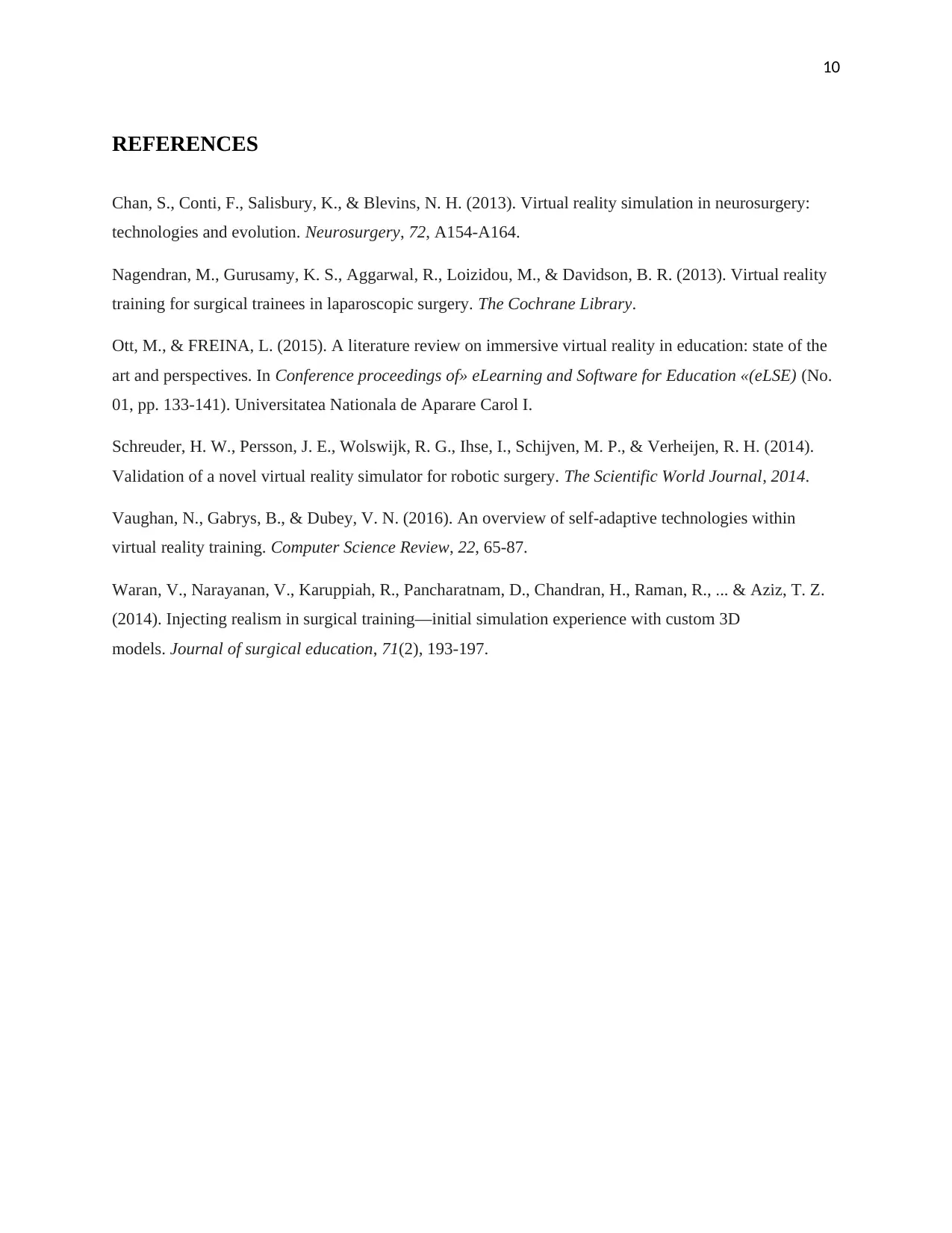
10
REFERENCES
Chan, S., Conti, F., Salisbury, K., & Blevins, N. H. (2013). Virtual reality simulation in neurosurgery:
technologies and evolution. Neurosurgery, 72, A154-A164.
Nagendran, M., Gurusamy, K. S., Aggarwal, R., Loizidou, M., & Davidson, B. R. (2013). Virtual reality
training for surgical trainees in laparoscopic surgery. The Cochrane Library.
Ott, M., & FREINA, L. (2015). A literature review on immersive virtual reality in education: state of the
art and perspectives. In Conference proceedings of» eLearning and Software for Education «(eLSE) (No.
01, pp. 133-141). Universitatea Nationala de Aparare Carol I.
Schreuder, H. W., Persson, J. E., Wolswijk, R. G., Ihse, I., Schijven, M. P., & Verheijen, R. H. (2014).
Validation of a novel virtual reality simulator for robotic surgery. The Scientific World Journal, 2014.
Vaughan, N., Gabrys, B., & Dubey, V. N. (2016). An overview of self-adaptive technologies within
virtual reality training. Computer Science Review, 22, 65-87.
Waran, V., Narayanan, V., Karuppiah, R., Pancharatnam, D., Chandran, H., Raman, R., ... & Aziz, T. Z.
(2014). Injecting realism in surgical training—initial simulation experience with custom 3D
models. Journal of surgical education, 71(2), 193-197.
REFERENCES
Chan, S., Conti, F., Salisbury, K., & Blevins, N. H. (2013). Virtual reality simulation in neurosurgery:
technologies and evolution. Neurosurgery, 72, A154-A164.
Nagendran, M., Gurusamy, K. S., Aggarwal, R., Loizidou, M., & Davidson, B. R. (2013). Virtual reality
training for surgical trainees in laparoscopic surgery. The Cochrane Library.
Ott, M., & FREINA, L. (2015). A literature review on immersive virtual reality in education: state of the
art and perspectives. In Conference proceedings of» eLearning and Software for Education «(eLSE) (No.
01, pp. 133-141). Universitatea Nationala de Aparare Carol I.
Schreuder, H. W., Persson, J. E., Wolswijk, R. G., Ihse, I., Schijven, M. P., & Verheijen, R. H. (2014).
Validation of a novel virtual reality simulator for robotic surgery. The Scientific World Journal, 2014.
Vaughan, N., Gabrys, B., & Dubey, V. N. (2016). An overview of self-adaptive technologies within
virtual reality training. Computer Science Review, 22, 65-87.
Waran, V., Narayanan, V., Karuppiah, R., Pancharatnam, D., Chandran, H., Raman, R., ... & Aziz, T. Z.
(2014). Injecting realism in surgical training—initial simulation experience with custom 3D
models. Journal of surgical education, 71(2), 193-197.

11
Marking Sheet:
Contents Discussion Mark
Excellent Good Adequate Unsatisfactory
1. Title page 2
2. Table of Contents 2
3. Introduction 11
4. History/ Evolution 11
5. Detailed description &
characteristics of topic
11
6. Key Components 11
7. Architecture 11
8. Advantages, Opportunities &
Limitations
11
9. Findings and Recommendation 11
10. List of references 9
Structure & Writing Style of Report 10
Total Marks –Report /100
Marking Sheet:
Contents Discussion Mark
Excellent Good Adequate Unsatisfactory
1. Title page 2
2. Table of Contents 2
3. Introduction 11
4. History/ Evolution 11
5. Detailed description &
characteristics of topic
11
6. Key Components 11
7. Architecture 11
8. Advantages, Opportunities &
Limitations
11
9. Findings and Recommendation 11
10. List of references 9
Structure & Writing Style of Report 10
Total Marks –Report /100
⊘ This is a preview!⊘
Do you want full access?
Subscribe today to unlock all pages.

Trusted by 1+ million students worldwide
1 out of 12
Related Documents
Your All-in-One AI-Powered Toolkit for Academic Success.
+13062052269
info@desklib.com
Available 24*7 on WhatsApp / Email
![[object Object]](/_next/static/media/star-bottom.7253800d.svg)
Unlock your academic potential
Copyright © 2020–2025 A2Z Services. All Rights Reserved. Developed and managed by ZUCOL.





